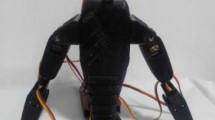Abstract.
A model-based approach to reconstruction of 3D human arm motion from a monocular image sequence taken under orthographic projection is presented. The reconstruction is divided into two stages. First, a 2D shape model is used to track the arm silhouettes and second-order curves are used to model the arm based on an iteratively reweighted least square method. As a result, 2D stick figures are extracted. In the second stage, the stick figures are backprojected into the scene. 3D postures are reconstructed using the constraints of a 3D kinematic model of the human arm. The motion of the arm is then derived as a transition between the arm postures. Applications of these results are foreseen in the analysis of human motion patterns.
Similar content being viewed by others
Author information
Authors and Affiliations
Additional information
Received: 26 January 1996 / Accepted: 17 July 1997
Rights and permissions
About this article
Cite this article
Filova, V., Solina, F. & Lenarčič, J. Automatic reconstruction of 3D human arm motion from a monocular image sequence. Machine Vision and Applications 10, 223–231 (1998). https://doi.org/10.1007/s001380050074
Issue Date:
DOI: https://doi.org/10.1007/s001380050074




